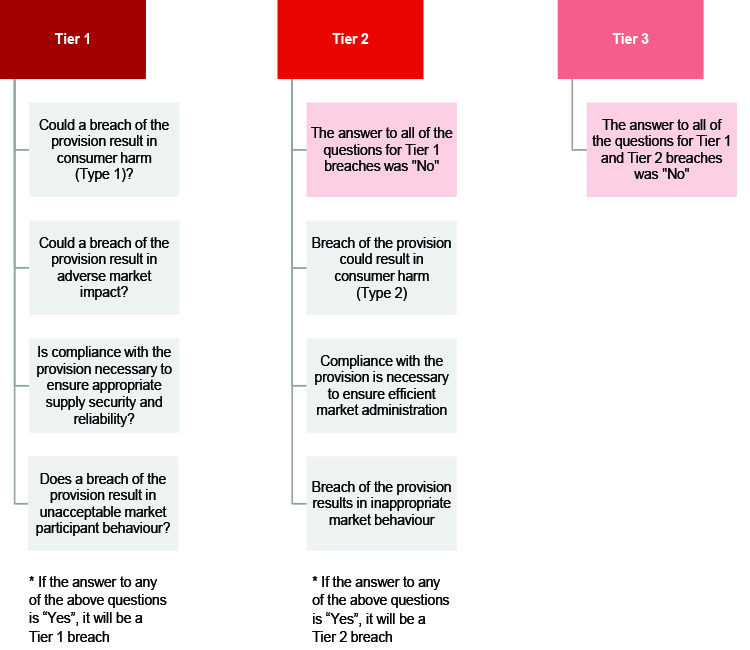
Publication
International arbitration report
In this edition, we focused on the Shanghai International Economic and Trade Arbitration Commission’s (SHIAC) new arbitration rules, which take effect January 1, 2024.


Author:
Australia | Publication | February 2021
On 29 January 2021, reforms to Australia’s energy laws came into effect, significantly increasing the maximum penalties, and expanding the investigatory powers of the Australian Energy Regulator (AER).1
These changes bolster the enhanced-level scrutiny of the industry and enforcement focus by the AER in recent years.
A key feature of the new regime is the implementation of a three-tier penalty structure which reflects three categories of breaches, ranked by severity. The maximum penalties within each tier are a substantial scaling-up of the penalties that were previously available to the AER and the courts.
The three tiers of civil penalty provisions for corporations are as follows:2
| Tier 1 | Maximum penalty is the greatest of $10 million, three times the value of the benefit obtained, and 10% of annual turnover |
| Tier 2 | Maximum penalty is up to $1,435,000 plus $71,800 per day for continuing breaches |
| Tier 3 | Maximum penalty is up to $170,000 plus $17,000 per day for continuing breaches |
Each of the civil penalty provisions within the National Electricity Rules, National Gas Rules and National Energy Retail Rules have been assigned a penalty tier, through amendments to the relevant regulations. The rationale for the how each civil penalty provision has been classified is summarised below.3
These reforms were intended to establish a more flexible and sophisticated penalty regime, more closely aligned by magnitude to those available to the Australian Competition and Consumer Commission under the Competition and Consumer Act 2010 (Cth), and to encourage greater compliance through the imposition of penalties which sufficiently deter contravening behaviour.4

In addition to the changes to the penalty regime, new enforcement powers have been conferred upon the AER, effectively strengthening the AER’s enforcement mandate.
These new powers include the ability to:
The above legislative changes accompany the AER’s increasing enforcement focus in recent years.
In 2019, for the first time, the AER released compliance and enforcement priorities to guide its work. This was complemented by the release of a refreshed Compliance and Enforcement Policy in July 2019 and the creation of a new AER Enforcement and Compliance Committee. Notably, the Policy states the following:
“Our approach to compliance focuses on preventing and addressing consumer harm and ensuring the effective operation of the energy market and efficient operations of networks. It enables us to hold to account specific businesses that fail to comply with their obligations under the national energy laws. It allows us to leverage enforcement outcomes across the sector and achieve the strategic benefits of general deterrence.”5
This strengthened enforcement policy has been reflected by a notable increase in the AER’s recent enforcement activity. In 2019-2020, the AER undertook twice as many compliance and enforcement actions as it had in the past, including the commencement of eight civil proceedings. In 2020, the following penalties were also ordered by the Federal Court, after action taken by the AER:
The number of civil proceedings commenced by the AER in recent years suggests a renewed appetite of the AER to litigate contraventions of the national energy laws, rather than accepting administrative remedies such as enforceable undertakings or issuing infringement notices.
The compliance concerns agitated by the AER in its recent enforcement actions accord with the new penalty regime’s tiered approach to categorising conduct. Conduct that could harm consumers, adversely impact the market, undermine system security or amount to failure to manage record keeping and reporting to a standard required by participants in this essential industry will therefore remain as key areas of focus of the AER.
We consequently expect an uptick in the amount of enforcement action taken by the AER in future, or at least an increase in the severity of enforcement outcomes.
These changes provide a timely reminder of the importance of ensuring that energy businesses have sufficient safeguards in place to facilitate their ongoing compliance with the national energy laws.
We assist organisations across the energy supply chain to assess and strengthen compliance and respond to regulatory inquiries and enforcement action. Please contact us if you have any queries.
Thank you to Rachel Murphy and Carty Chan for their assistance in preparing this article.
The Statues Amendment (National Energy Laws) (Penalties and Enforcement) Act 2020 (SA).
The reforms also provide for a periodic indexation of penalties in line with the consumer price index, with the first indexation to occur in 2023.

Publication
In this edition, we focused on the Shanghai International Economic and Trade Arbitration Commission’s (SHIAC) new arbitration rules, which take effect January 1, 2024.

Publication
EU Member States may allow companies from countries that have not concluded an agreement guaranteeing equal and reciprocal access to public procurement (public procurement agreement) with the EU to participate in public tenders, provided there is no EU act excluding the relevant country.
Subscribe and stay up to date with the latest legal news, information and events . . .
© Norton Rose Fulbright LLP 2023